Best Apps to Check Mac Hard Drive Health
Your Mac’s hard drive is one of its most essential components. A failing hard drive can turn your high-performance Mac into nothing more than an expensive decoration. Learning how to check hard drive health on your Mac is essential to prevent data loss and maintain system performance. Many tools and utilities are designed to help you maintain the health of your hard drive. In this article, we are going to look at the best software solutions for checking disk health on your Mac so you can find the right app for your situation.
Best Mac Hard Drive Testing Software Summary
| Evaluation criteria | Software |
| 💗 Best overall | DriveDx |
| 🌡️ Best for S.M.A.R.T. monitoring | Disk Drill |
| ⚙️ Best for repairing disks | Disk Utility |
| 📉 Best for speed testing | Blackmagic Disk Speed Test |
| 🛡️ Best additional features | Disk Drill |
| 📊 Best disk statistics | iStat Menu |
| 💽 Best for freeing disk space | CleanMyDrive 2 |
Why Should You Test Your Mac’s Disks?
Having a well-performing hard disk drive (HDD) or solid-state drive (SSD) is a critical factor in the overall performance and functionality of your Mac or MacBook. A disk in poor health can result in slower system response time and can eventually lead to data loss. The worst-case scenario is that your drive fails completely and you cannot start your computer.
Testing your Mac’s disks regularly can give you an indication when the device is not performing optimally. You may also want to test the drive to determine the extent of damage or corruption if you start to experience issues like missing files. It is foolish to ignore any signs that your disk may be acting up. Failure to act quickly may lead to a data loss situation that could have been avoided with some preemptive actions.
How to Check Hard Drive Health on a Mac
There are multiple ways to check the hard drive health on your Mac. You can scan the disk on your Mac to determine if there are any errors or bad sectors on the device with a Mac HDD tester like Disk Utility using a simple procedure.
Follow next steps for Checking Hard Drive Health on Mac:
- Open Disk Utility, found within the /Applications/Utilities folder.
- Select the disk from the available devices.
- Click on First Aid to check your drive for errors.

- Click on “Verify Disk” in the lower right corner
- Disk Utility will report on the status of the drive and attempt to fix errors.
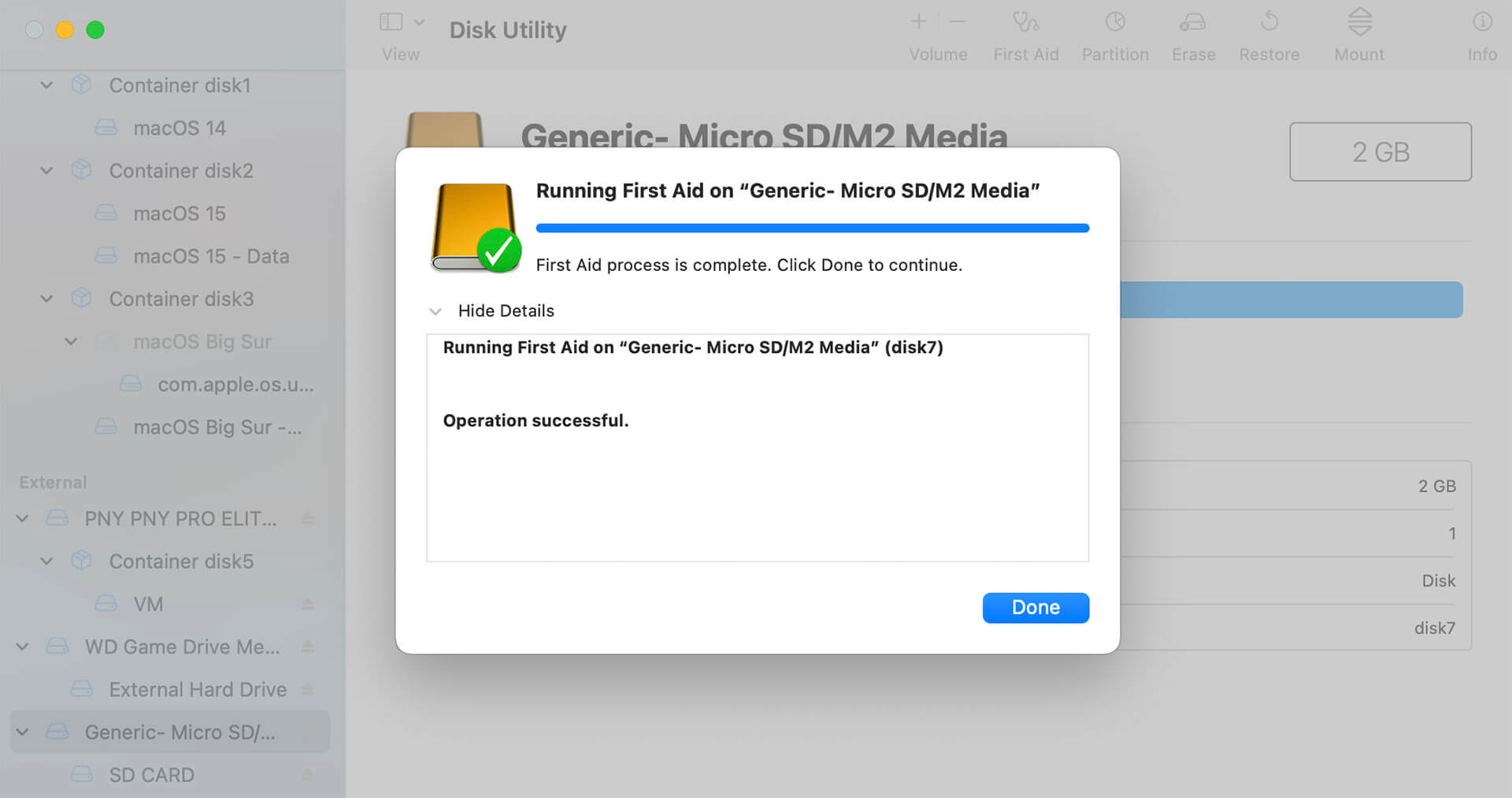
You can also run monitoring software that provides real-time information regarding your disks and alerts you to impending issues. Some of the tools we have looked at generate warnings while others require you to review the details manually to determine the state of your drives. Both approaches are valid, and one may work better for your specific needs.
Features to Look for in Apps to Check Mac Hard Drive Health
Choosing the right app to monitor your Mac’s hard drive health requires you to consider several essential features that enhance functionality and user experience. Here are the key features you should look for:
- S.M.A.R.T. monitoring: Choose apps that incorporate Self-Monitoring, Analysis, and Reporting Technology (S.M.A.R.T.). This feature provides preemptive warnings about potential drive failures, helping you address problems before they escalate.
- Disk repair tools: These tools should allow you to correct errors and repair file systems, enabling proactive maintenance and issue resolution directly through the app.
- User-friendly interface: The application should be straightforward and easy to navigate, enabling users of all technical levels to effectively utilize its features.
- Detailed diagnostics: Look for apps that offer comprehensive reports and diagnostics. These insights help you manage your hard drive’s health more proactively and make timely upgrades.
- Data recovery solutions: Seek features that support file recovery and disk cloning, which are invaluable for retrieving important data after accidental deletions or severe disk damage.
- Consistent updates and support: Make sure the app receives regular updates to support the latest macOS versions and hardware changes. Reliable customer support is crucial for resolving any issues you encounter.
- Minimal performance impact: Find apps that operate efficiently in the background, minimizing resource consumption and avoiding any slowdowns in system performance during their operation.
Apps to Check Mac Hard Drive Health Testing Statistics:
| Number of Software tested on Mac: | 8 |
| How long we test tools: | 1 month |
| OS version: | macOS Sonoma |
| S.M.A.R.T. Technology: | Yes/No |
8 Apps That Perform a Mac Hard Drive Test
Here’s an overview of eight apps that you can use to check hard drive health on a Mac. They don’t all have the same level of functionality and some are more useful for specific issues you may be experiencing with your Mac’s disks.
1. Disk Utility
S.M.A.R.T. Technology: Yes | Speed: Good | System requirements: Installed as part of macOS | Main Function: disk repair and verification
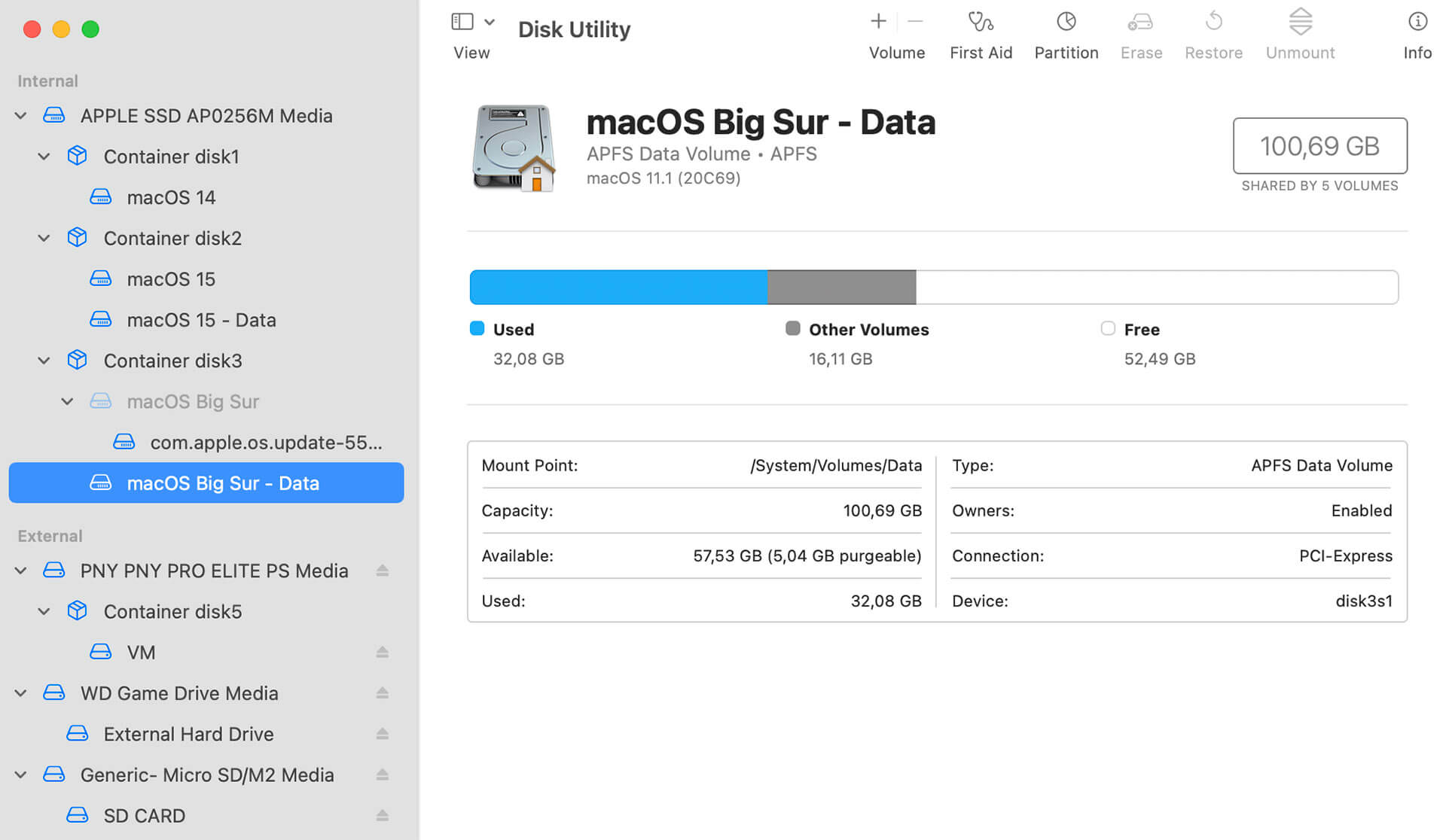
Overview:
Disk Utility is a built-in macOS app that can be used to perform a variety of tasks on your Mac’s disks. The First Aid function in Disk Utility checks for errors and makes repairs under certain circumstances. Disk Utility cannot fix all disk problems and may deliver a report that indicates your disk will soon fail. If that is the case, backup your data as soon as possible and consider replacing the drive.
Key Features:
- Disk formatting and partitioning;
- Erase disks;
- Displaying disk information such as capacity and S.M.A.R.T. status.
- Free with macOS
- Supported by Apple
- Limited monitoring capability
- Free tool included as part of your macOS installation
2. Disk Drill Disk Health Tool
S.M.A.R.T. Technology: Yes | Speed: Good | System requirements: Runs on all versions of macOS or OS X | Main Function: S.M.A.R.T. monitoring and data recovery
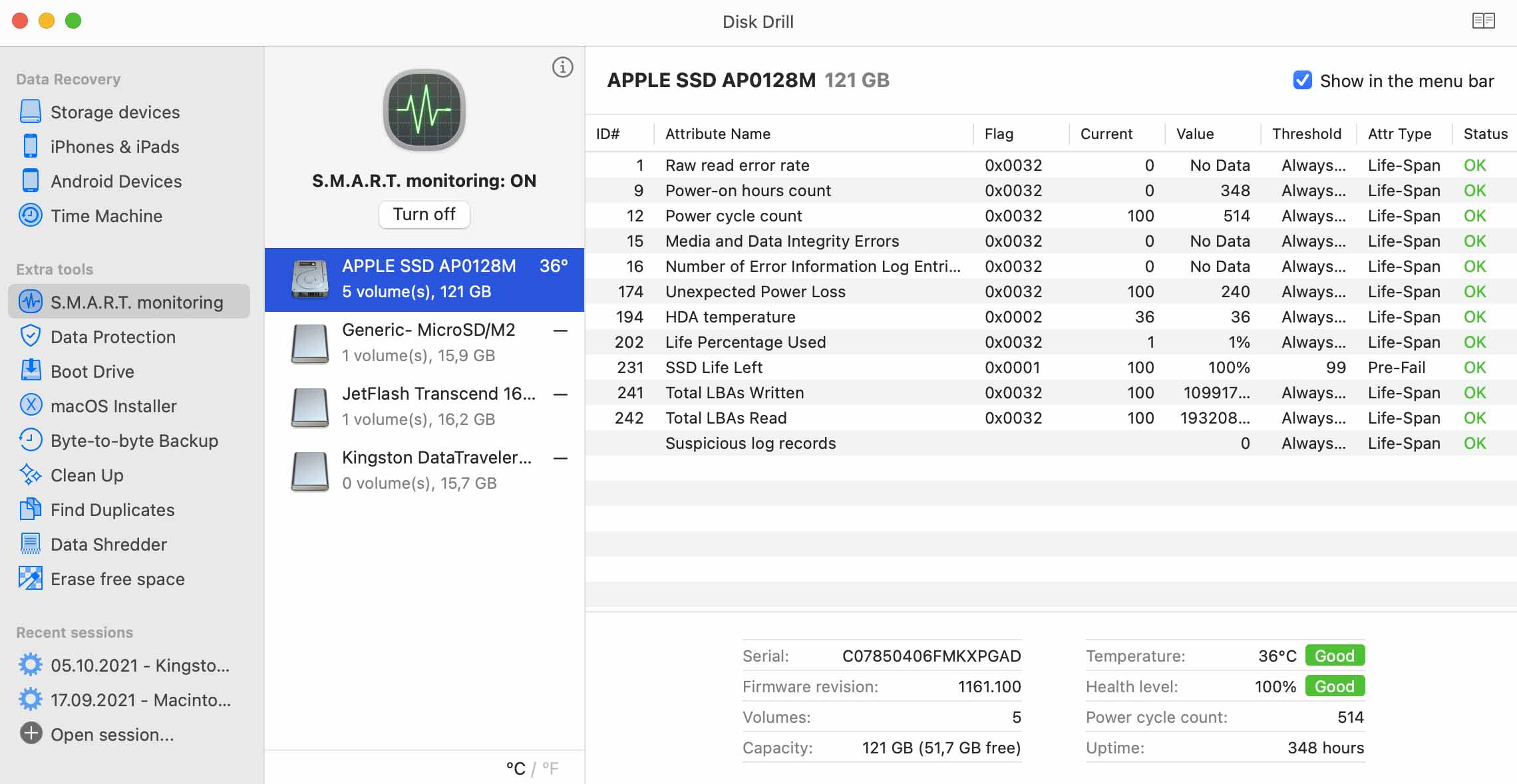
Overview:
Disk Drill is data recovery software that can also check SSD health on your Mac. You can choose to have Disk Drill monitor the state of your SSD drive and display warning messages if it detects problems. On Macs shipped before 2016, you can also view S.M.A.R.T. details. Unfortunately, Apple has disabled that option on newer Mac models.
Key Features:
- Recover lost and deleted data;
- Create bootable disks;
- Free data protection tools;
- Find duplicate files;
- Shred data;
- Create byte-level backups for data recovery.
- Extensive data recovery and protection tools
- Limited disk monitoring capability
- Free tool included as part of Disk Drill’s trial download. A full license for the Pro version of Disk Drill data recovery is $89
3. CleanMyMac
S.M.A.R.T. Technology: No | Speed: Good | System requirements: Available for all macOS versions | Main Function: verify the startup disk and free disk space
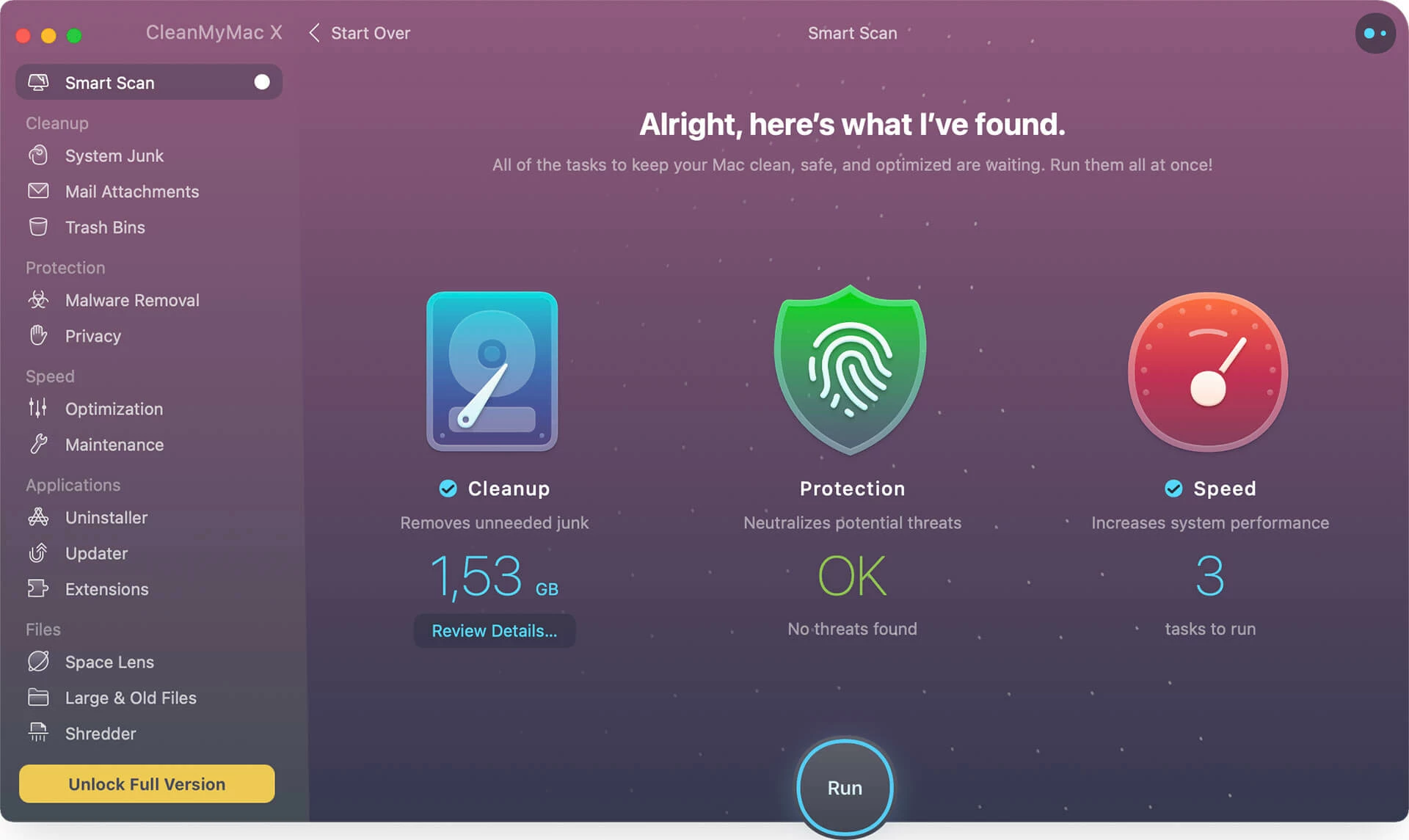
Overview:
CleanMyMac is designed to remove temporary and junk files from your Mac’s hard drive to give you more space and increase your computer’s response speed. The tool will inform you when there are files that can be removed and lets you know how much space you can save by performing a disk cleaning.
Key Features:
- Removes browsing history to protect privacy;
- Find and remove malware.
- Frees disk storage
- Malware removal
- Requires a yearly subscription
- Free trial available. A yearly subscription for one Mac is $39.95
4. Mac Cleaner
S.M.A.R.T. Technology: No | Speed: Good | System requirements: macOS macOS 10.9+ | Main Function: freeing disk space
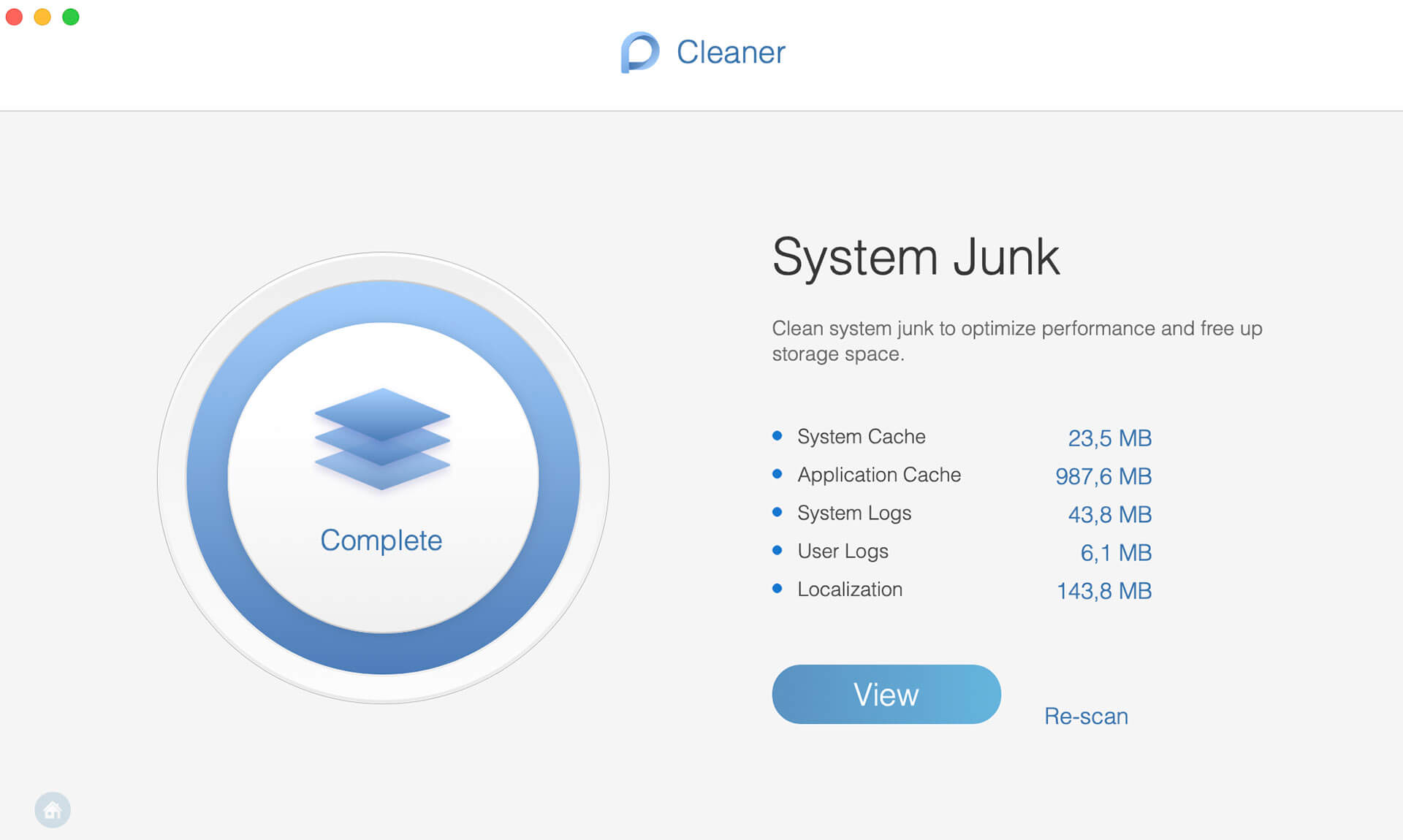
Overview:
Mac Cleaner is a multi-purpose tool that can help free up valuable disk space for more effective use of your storage devices. It can also monitor various aspects of your Mac such as memory and CPU utilization.
- Encrypt private data
- Uninstalls applications with one click
- Finds duplicate files
- Free trial, $29.95 for a lifetime license
5. Blackmagic Disk Speed Test
S.M.A.R.T. Technology: No | Speed: Excellent | System requirements: macOS 10.13.0 or later | Main Function: testing disk read/write speed

Overview:
If you work with large video files, the read and write speed of your hard disk can be vitally important. This tool is a single function application that tests the speed at which your disk is operating. You can continuously monitor if you desire to see if performance is impacted over time.
- Strictly a disk read/write speed monitoring tool
- Free from the Mac App Store
6. DriveDx
S.M.A.R.T. Technology: Yes | Speed: Good | System requirements: macOS OS X 10.6+ | Main Function: disk diagnostics and monitoring
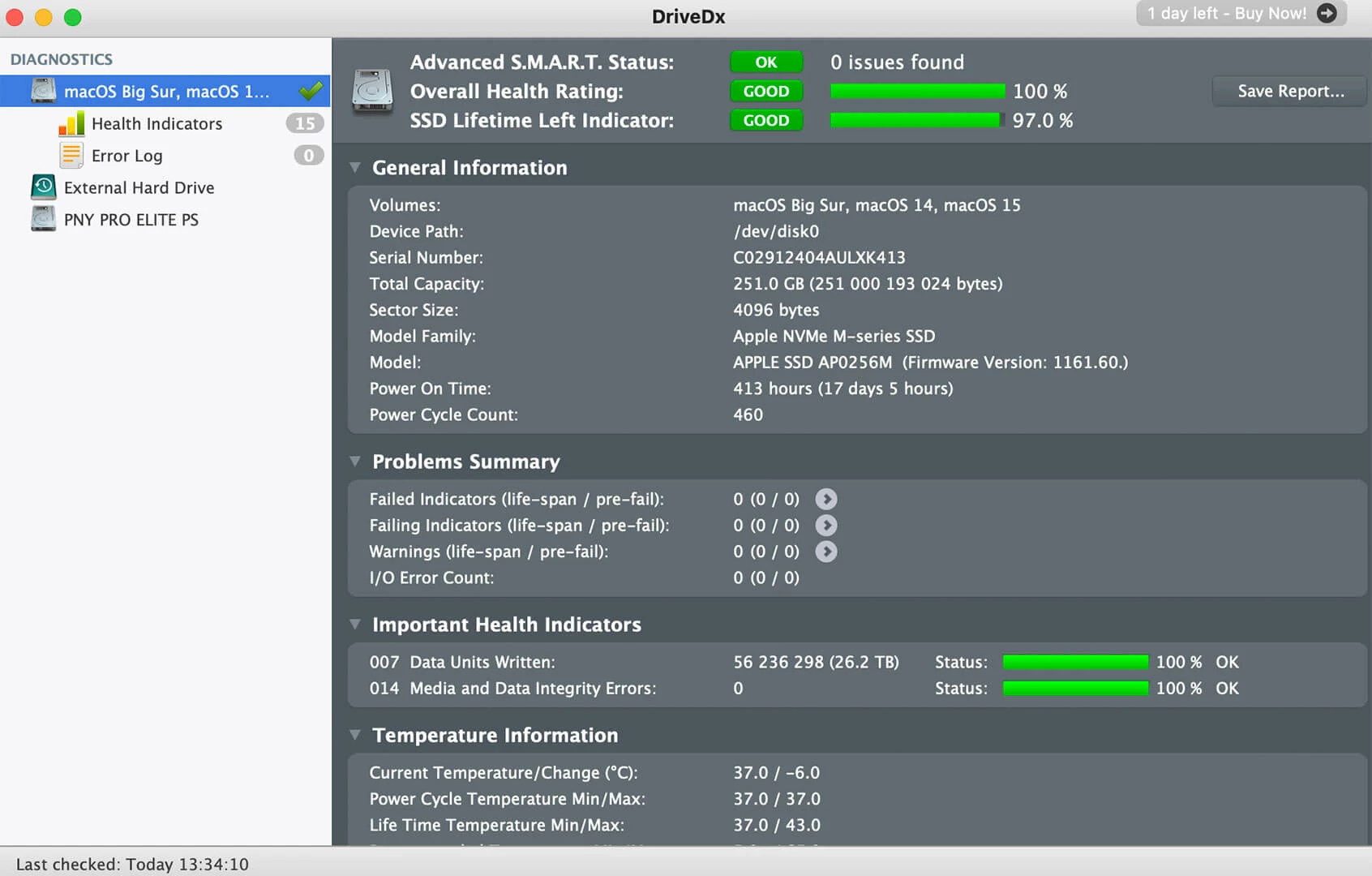
Overview:
DriveDx offers real-time disk monitoring that is designed to alert you before your HDD or SSD fails. The tool provides key metrics regarding the health and performance of your drives to let you know when problems occur. It uses different algorithms to perform a more complete assessment of the state of HDD or SSD drives.
- Automated email reports
- Modern and intuitive user-interface
- Early warning system for drive problems
- Free trial, $19.99 for a personal license
7. iStat Menus
S.M.A.R.T. Technology: Yes | Speed: Good | System requirements: macOS 10.11 or later | Main Function: detailed disk monitoring

Overview:
iStat Menu is a full-featured monitoring application that can check the disk on a Mac as well as perform many other diagnostic activities. It displays free and used disk space, S.M.A.R.T. status, and provides statistics on disk I/O. The tool gives you an impressive array of information regarding the health of your Mac’s disk and about the system in general.
Key Features:
- Monitor CPU and GPU usage;
- Memory and network statistics;
- Customizable notifications for many aspects of your Mac.
- Provides extensive system information
- May be too complex for novice users
- $9.99 from Mac App Store
8. CleanMyDrive 2
S.M.A.R.T. Technology: No | Speed: Good | System requirements: macOS 10.10 or higher | Main Function: freeing up disk space

Overview:
This tool does exactly what its name implies. It keeps your drive free of junk and unnecessary files that reduce your storage capacity and slow down your computer. You can use this app to clean your Mac’s internal or external drives. Handcrafted icons for each drive make it easier to view and determine which one is having issues.
Key Features:
- Copy files to any drive by dragging them into the app;
- Eject multiple drives with a single click.
- Powerful freeware tool
- No disk health monitoring
- Free from the Mac App Store
Summary
The collection of tools and applications we have presented covers many different issues that your Mac’s hard drive might be experiencing. Whether you want to run a Mac HDD test to verify read and write speed, monitor your S.M.A.R.T. status, search for and repair errors, or remove unwanted junk files, there is an app out there for you. All of the apps are free or have a free trial, so there’s no excuse for not trying them. Take good care of your Mac’s disks and they will keep your machine running optimally.
FAQ
You can use Disk Utility to check the health of your Mac’s hard drive with the following procedure:
- Open Disk Utility, found within the /Applications/Utilities folder.
- Select the disk from the available devices.
- Click on First Aid to check your drive for errors.
- Click on “Verify Disk” in the lower right corner
- Disk Utility will report on the status of the drive and attempt to fix errors.
Disk Utility will display the S.M.A.R.T. status of your SSD. Follow these steps:
- Open Disk Utility.
- Select the disk from the available devices.
- S.M.A.R.T. status is displayed in the bottom left box.
The signs of a failing hard drive include:
- Missing files;
- Slow system response;
- Corrupt or damaged files;
- System crashes.
Follow these steps to run a diagnostic test on your Mac. The steps vary based on the type of processor in your Mac.
All processors
- Shutdown the Mac and place it on a hard, flat surface with good ventilation.
- Disconnect all external devices except keyboard, mouse, display, Ethernet connection (if applicable), and connection to AC power.
Apple silicon processor
- Turn on the Mac and press and hold the power button while it starts.
- Release the button when you see the startup options window.
- Press Command (⌘)-D on your keyboard.
Intel Processor
Turn on your Mac, then immediately press and hold the D key on your keyboard as your Mac starts up.
Release when you see a progress bar or you’re asked to choose a language.
